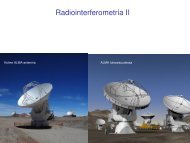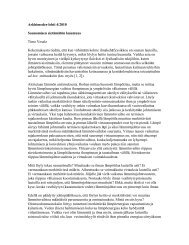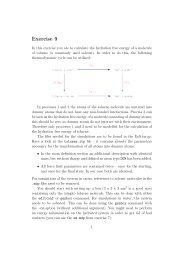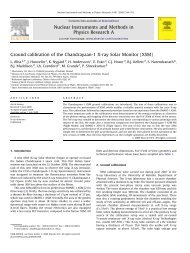Astrochimistry – Spring 2013 Interstellar PAHs
Astrochimistry â Spring 2013 Interstellar PAHs - Course Pages of ...
Astrochimistry â Spring 2013 Interstellar PAHs - Course Pages of ...
- No tags were found...
Create successful ePaper yourself
Turn your PDF publications into a flip-book with our unique Google optimized e-Paper software.
<strong>Astrochimistry</strong> <strong>–</strong> <strong>Spring</strong> <strong>2013</strong><br />
Lecture 4:<br />
<strong>Interstellar</strong> <strong>PAHs</strong><br />
NGC 7023 - HST<br />
Julien Montillaud<br />
8 th February <strong>2013</strong>
Outline<br />
I. From Unidentified to Aromatic Infrared Bands (7 p.)<br />
I.1 Historical background<br />
I.2 Observational evidence<br />
I.3 The PAH hypothesis<br />
II. General properties of “chemical” <strong>PAHs</strong> (9 p.)<br />
II.1 Overview of the PAH family<br />
II.2 Electronic properties<br />
II.3 Vibrational properties<br />
III. Evolution of interstellar <strong>PAHs</strong> (15 p.)<br />
III.1 Observational evidence<br />
III.2 Dissociation of <strong>PAHs</strong><br />
III.3 Reactivity of <strong>PAHs</strong><br />
III.4 Formation of <strong>PAHs</strong><br />
IV. Influence of <strong>PAHs</strong> on the ISM evolution (3 p.)<br />
IV.1 Extinction curve<br />
IV.2 Photoelectric effect<br />
IV.3 Formation of H 2<br />
V. Summary<br />
VI. Some bibliographic references<br />
2
I. From Unidentified to Aromatic Infrared Bands<br />
I.1 Historical background<br />
Gillett et al. (1967): IR excess in the ?? range compared to free-free radio continuum<br />
extrapolation<br />
Russell et al. (1977): unidentified IR bands at 3.3, 3.4, 6.2, 7.7, 8.6 & 11.3 µm from reflection<br />
nebulea<br />
Duley & Williams (1981): notice the match between some PAH spectral features and UIBs<br />
Sellgren et al. (1983): near IR emission from reflection nebulae inconsistant<br />
with UV-photons thermally excited dust grains => transient heating of small particles ?<br />
Léger & Puget (1984): the “first first” attribution of UIBs to <strong>PAHs</strong><br />
(transient heating excitation model)<br />
Allamandola, Tielens & Barker (1985): the “second first” attribution of UIBs to <strong>PAHs</strong><br />
(non thermal excitation model)<br />
Désert et al. (1990): global model of dust grains including <strong>PAHs</strong><br />
1990': first big experiments and detailed theoretical models + Infrared Space Observatory era<br />
2000': multiplication of experiments and detailed models + Spitzer Space Telescope era<br />
3
I. From Unidentified to Aromatic Infrared Bands<br />
I.2 Observational evidence<br />
NGC 7023<br />
4
I. From Unidentified to Aromatic Infrared Bands<br />
I.2 Observational evidence<br />
HII region<br />
Edge of molecular cloud<br />
NGC 7023<br />
Proto-planetary nebula<br />
5<br />
Planetary nebula
I. From Unidentified to Aromatic Infrared Bands<br />
I.2 Observational evidence<br />
Band positions: typical of C-H and<br />
C-C stretches or bends in aromatic<br />
material<br />
Plateaux at short wavelength:<br />
High temperature, small species<br />
Simple reasoning:<br />
→ Plateau up to ~3.4 µm<br />
→ T~1000 K (black body approx.)<br />
→ 1 photon @ E=10 eV<br />
→ Cv=3kN=E/T<br />
=> N=39 atoms<br />
Possible reading: Sellgren (1984)<br />
6
I. From Unidentified to Aromatic Infrared Bands<br />
I.3 The PAH hypothesis<br />
Astrophysical PAH = carrier of the Aromatic Infrared Bands<br />
PAH = polycyclic aromatic hydrocarbon<br />
“chemical” PAH = one model for “astrophysical” PAH<br />
Other models are reasonnable<br />
Graphitic grains/<br />
PAH clusters<br />
Free flying PAH<br />
molecules<br />
Hydrogenated<br />
amorphos carbon<br />
7
I. From Unidentified to Aromatic Infrared Bands<br />
I.3 The PAH hypothesis<br />
Still no individual spectroscopic identification<br />
Pilleri et al. 2009<br />
Pilleri et al. 2009<br />
Kokkin et al. 2008<br />
Not symmetric<br />
→ permanent electric dipole<br />
→ strong rotational emission<br />
…<br />
Undetected in Red Rectangle<br />
in the millimetric range (1→3mm)<br />
at IRAM-30m<br />
Electronic transition<br />
in the visible<br />
8
Related detections<br />
I. From Unidentified to Aromatic Infrared Bands<br />
I.3 The PAH hypothesis<br />
Fullerene C60: not a PAH, but very close<br />
Also:<br />
- C 70<br />
- C 6<br />
H 6<br />
9
II. General properties of “chemical” <strong>PAHs</strong><br />
I. From Unidentified to Aromatic Infrared Bands<br />
II. General properties of “chemical” <strong>PAHs</strong><br />
II.1 Overview of the PAH family<br />
II.2 Electronic properties<br />
II.3 Vibrational properties<br />
III. Grain-catalyzed formation of H 2<br />
IV. From processes to interstellar H 2<br />
formation rate<br />
V. Summary<br />
10
II. General properties of “chemical” <strong>PAHs</strong><br />
II.1 Overview of the PAH family<br />
5-cycles<br />
Catacondensed<br />
Irregular<br />
Pericondensed<br />
11
Electron delocalization (=resonance) and aromaticity<br />
II. General properties of “chemical” <strong>PAHs</strong><br />
II.2 Electronic properties<br />
Molecular orbitals = combination of atomic orbitals<br />
original p-atomic orbitals<br />
Resulting molecular<br />
(delocalized) orbital<br />
Electrostatic potential<br />
map of benzene<br />
Images from Paula Yurkanis Bruice, Cleveland, OH -<br />
http://wps.prenhall.com/wps/media/objects/724/741576/chapter_07.html<br />
12
Electron delocalization (=resonance) and aromaticity<br />
II. General properties of “chemical” <strong>PAHs</strong><br />
II.2 Electronic properties<br />
• Bonding MO: constructive (in-phase) overlap<br />
• Antibonding MO: destructive (out-of-phase) overlap<br />
13
Electron delocalization (=resonance) and aromaticity<br />
II. General properties of “chemical” <strong>PAHs</strong><br />
II.2 Electronic properties<br />
n(e) = 4n+2 => extra stabilisation (aromatic)<br />
n(e) = 4n => extra de-stabilisation (anti-aromatic)<br />
n(e) = 4n+1 or 4n+3 => nothing special<br />
NB:<br />
- changing the charge changes the aromaticity<br />
- changing the number of H-atoms changes the aromaticity<br />
Le Page et al. 2001<br />
14
II. General properties of “chemical” <strong>PAHs</strong><br />
II.2 Electronic properties<br />
Ionization potential<br />
Empirical classical model: PAH = thin conducting disk<br />
Reasonable agreement with detailed quantum calculations (Density Functional Theory)<br />
Z=1 Z=2<br />
Malloci et al. 2007<br />
15
II. General properties of “chemical” <strong>PAHs</strong><br />
II.2 Electronic properties<br />
Electronic spectrum<br />
Extinction curve<br />
Visible<br />
UV<br />
→ *<br />
Lyman cut (13.6 eV)<br />
→ *<br />
→ *<br />
→ *<br />
16
II. General properties of “chemical” <strong>PAHs</strong><br />
II.2 Electronic properties<br />
Electronic spectrum<br />
E n<br />
~ n / L<br />
n=level number<br />
E n<br />
= energy of level n<br />
L = well width<br />
17
II. General properties of “chemical” <strong>PAHs</strong><br />
II.3 Vibrational properties<br />
Experimental spectra<br />
Theoretical spectra<br />
Joblin et al. 1994<br />
http://www.astrochem.org/pahdb/<br />
18
II. General properties of “chemical” <strong>PAHs</strong><br />
II.3 Vibrational properties<br />
PAH spectroscopy: only little variations<br />
Neutral<br />
Anion<br />
-<br />
-<br />
-<br />
-<br />
19
III. Evolution of interstellar <strong>PAHs</strong><br />
I. From Unidentified to Aromatic Infrared bands<br />
II. General properties of “chemical” <strong>PAHs</strong><br />
III. Evolution of interstellar <strong>PAHs</strong><br />
III.1 Observational evidence<br />
III.2 Photodissociation of <strong>PAHs</strong><br />
III.3 Reactivity of <strong>PAHs</strong><br />
III.4 Formation of <strong>PAHs</strong><br />
IV. From processes to interstellar H 2<br />
formation rate<br />
V. Summary<br />
20
In HII regions and reflection nebulae: from region to region<br />
III. Evolution of interstellar <strong>PAHs</strong><br />
III.1 Observational evidence<br />
Peeters et al. 2004 & 2002<br />
21
In the reflection nebulae NGC 7023: within one region<br />
III. Evolution of interstellar <strong>PAHs</strong><br />
III.1 Observational evidence<br />
Berné et al. 2007<br />
Peeters et al. 2004 & 2002<br />
22
III. Evolution of interstellar <strong>PAHs</strong><br />
III.2 Photodissociation of <strong>PAHs</strong><br />
Direct photodissociation ?<br />
→ apparently not efficient<br />
(Buch 1989, Jochims et al. 1994)<br />
Other possibility:<br />
→ statistical photodissociation<br />
23
III. Evolution of interstellar <strong>PAHs</strong><br />
III.2 Photodissociation of <strong>PAHs</strong><br />
Relaxation processes of an isolated PAH<br />
IVR: internal vibrational redistribution<br />
IC: internal conversion<br />
24
III. Evolution of interstellar <strong>PAHs</strong><br />
III.2 Photodissociation of <strong>PAHs</strong><br />
(diagram for a PAH cluster, but similar to H-loss or C-loss for an isolated PAH molecule)<br />
25
III. Evolution of interstellar <strong>PAHs</strong><br />
III.2 Photodissociation of <strong>PAHs</strong><br />
Arrhenius law<br />
k diss<br />
(T) = A diss<br />
exp(-E 0<br />
/kT)<br />
k diss<br />
= dissociation rate coefficient<br />
T = vibrational temperature<br />
→ also kinetic temperature if enough<br />
collisions for thermalization<br />
A diss<br />
= prefactor<br />
E 0<br />
= dissociation energy<br />
Laplace<br />
transform<br />
Approximated microcanonical expression<br />
k diss<br />
= dissociation rate coefficient<br />
E = internal (vibrational) energy<br />
A diss<br />
= prefactor<br />
→ vibrational frequency<br />
→ entropy cost (structural changes)<br />
→ difficult to estimate theoretically,<br />
but not impossible<br />
E 0<br />
= dissociation energy<br />
= vibrational density of state(VDOS) of<br />
the parent molecule => one has to know<br />
26<br />
the vibrational modes
III. Evolution of interstellar <strong>PAHs</strong><br />
III.2 Photodissociation of <strong>PAHs</strong><br />
Anharmonicity<br />
= different from a parabolic potential well<br />
→ always the case for dissociation<br />
→ mode frequency vary<br />
with internal energy<br />
→ much more difficult to<br />
find the frequencies, and<br />
to compute VDOS from<br />
frequencies<br />
→ VDOS directly<br />
accessible from<br />
molecular dynamics<br />
simulations<br />
In practice, astronomers still use the harmonic VDOS<br />
27
III. Evolution of interstellar <strong>PAHs</strong><br />
III.2 Photodissociation of <strong>PAHs</strong><br />
General trends<br />
Ekern et al. 1998<br />
Experimental results:<br />
More compact =><br />
more photostable<br />
Bigger =><br />
more photostable<br />
Loss E 0<br />
[eV] A diss<br />
[s -1 ]<br />
H(even) 4.5-4.8 6.8e17<br />
H(odd) 3.2 6.8e17<br />
C 7.4 6.2e15<br />
C2 8.5 3.5e17<br />
C3 8.0 1.5e18<br />
(Joblin et al. <strong>2013</strong>, Léger et al. 1989)<br />
28
III. Evolution of interstellar <strong>PAHs</strong><br />
III.3 Reactivity of <strong>PAHs</strong><br />
Reactivity with hydrogen<br />
Montillaud et al. <strong>2013</strong><br />
No data on neutral<br />
Only qualitative data on super-hydrogenated (more H-atoms than in “normal” <strong>PAHs</strong>)<br />
Measurement/calculation for dehydrogenated only for small <strong>PAHs</strong><br />
Fast reactions with H<br />
No or slow reactions with H 2<br />
29
III. Evolution of interstellar <strong>PAHs</strong><br />
III.3 Reactivity of <strong>PAHs</strong><br />
Reactivity with other atoms<br />
Le Page et al. (1999)<br />
Fast reactions for normal and dehydrogenated cations with O and N<br />
=> it is likely that a more general population than strict <strong>PAHs</strong> populate the ISM<br />
Tentative “family identification”, using NASA Ames database, but not convincing (so far...)<br />
30
III. Evolution of interstellar <strong>PAHs</strong><br />
III.3 Reactivity of <strong>PAHs</strong><br />
Physisorption of bigger atoms (Si, Fe, ...)<br />
Joalland et al. (2009)<br />
Thermodynamically favorable<br />
Weak spectral signature => not impossible but difficult<br />
E 0<br />
= 1.5 eV => easily photodissociated<br />
31
III. Evolution of interstellar <strong>PAHs</strong><br />
III.3 Reactivity of <strong>PAHs</strong><br />
Aggregation of <strong>PAHs</strong><br />
(C 24<br />
H 12<br />
) 11<br />
(C 96<br />
H 24<br />
) 4<br />
32
III. Evolution of interstellar <strong>PAHs</strong><br />
III.3 Reactivity of <strong>PAHs</strong><br />
Aggregation of <strong>PAHs</strong><br />
Formation of PAH clusters:<br />
→ dilution of the excess energy within the numerous vibrational degrees of freedom<br />
(see movie, credit: Mathias Rapacioli, IRSAMC, Toulouse, France)<br />
Destruction of PAH clusters:<br />
→ analogous to PAH photodissociation<br />
→ difficulty to deal with all the degrees of freedom => rigid molecules approximation ?<br />
Spectroscopy of PAH clusters:<br />
→ are they responsible for continuum emission in the mid-IR ?<br />
33
III. Evolution of interstellar <strong>PAHs</strong><br />
III.4 Formation of <strong>PAHs</strong><br />
Asymptotic Giant Branch Stars (AGB)<br />
IRC 10216<br />
Cherchneff et al. 1992<br />
Shocks<br />
→ local dense and cold points<br />
→ condensation of some dust grains<br />
→ acceleration of grains by radiation pressure<br />
→ wind acceleration by dragging<br />
⇒ coupling stellar wind dynamics <strong>–</strong> dust formation<br />
34<br />
Model of AGB circumstellar material
III. Evolution of interstellar <strong>PAHs</strong><br />
III.4 Formation of <strong>PAHs</strong><br />
Most classical model: the HACA mechanism<br />
in circumstellar regions of AGB stars<br />
(H-abstraction, C-addition)<br />
Frenklach et al. 1984<br />
Consistent with observations ?<br />
CRL 2688<br />
IRC 10216<br />
AGB stars<br />
No UV<br />
Protoplanetary nebula: some UV<br />
IC 418<br />
Planetary nebula<br />
Intense UV RF<br />
35
IV. From processes to interstellar H 2<br />
formation rate<br />
I. From Unidentified to Aromatic Infrared Bands<br />
II. General properties of “chemical” <strong>PAHs</strong><br />
III. Evolution of interstellar <strong>PAHs</strong><br />
IV. Influence of <strong>PAHs</strong> on ISM evolution<br />
IV.1 Photoelectric heating<br />
IV.2 Extinction curve<br />
IV.3 Formation of H2<br />
V. Summary<br />
36
IV. Influence of <strong>PAHs</strong> on the ISM evolution<br />
IV.1 Photoelectric heating<br />
PDR model for NGC 7023<br />
37
IV. Influence of <strong>PAHs</strong> on the ISM evolution<br />
IV.2 Extinction curve<br />
38
IV. Influence of <strong>PAHs</strong> on the ISM evolution<br />
IV.3 Formation of H2<br />
Rauls & Hornekaer 2008<br />
39
V. Summary<br />
“Astronomical” <strong>PAHs</strong> are defined as the carriers of the AIBs<br />
“Chemical” <strong>PAHs</strong> are one good model for astronomical <strong>PAHs</strong><br />
→ no individual spectroscopic identification<br />
→ but identification of 3 large aromatic molecules: C 6<br />
H 6<br />
, C 60<br />
, C 70<br />
Many theoretical and experimental studies provide molecular data, but still not enough<br />
→ Theoretical spectral database of <strong>PAHs</strong> (Cagliari, Italy)<br />
→ NASA Ames PAH IR Spectroscopic Database<br />
Understanding is limited by:<br />
- confusion in mid-IR spectroscopy<br />
- scarcity in UV-visible spectroscopy<br />
- the huge number of parameters (e.g. molecule size, structure, charge, ...)<br />
- the absence of emission in UV-poor environments<br />
- the large size of interstellar <strong>PAHs</strong><br />
=> difficult (if not impossible) for both theoretical and experimental studies<br />
Deep coupling between PAH and ISM evolutions through photoelectric heating, extinction<br />
curve and H 2<br />
formation<br />
In the future, progresses should be achieved from on-going laboratory and theoretical studies<br />
40<br />
for large species + spectroscopic observations (DIBs, AIBs, far-IR rotation lines) + coupling<br />
with chemistry of other species (H 2<br />
formation/excitation, small hydrocarbons, evaporating VSGs)
VI. Some bibliographic references<br />
PAH review:<br />
- Tielens, A. G. G. M., The Physics and Chemistry of the <strong>Interstellar</strong> Medium, Cambridge University Press (2005)<br />
- Tielens, A. G. G. M., ARA&A, (2008)<br />
Chemical evolution:<br />
- Le Page et al., ApJSS, 132: 233-251, (2001)<br />
- Le Page et al., ApJ, 584: 316-330 (2003)<br />
-<br />
-<br />
Theoretical chemistry aspects (mainly for astronomers)<br />
- Malloci et al., A&A, 462: 627-635, (2007)<br />
- Léger et al. A&A, 213: 351-359 (1989)<br />
-<br />
Experimental chemistry aspects<br />
-<br />
-<br />
Modelling aspects<br />
-<br />
-<br />
-<br />
-<br />
41








